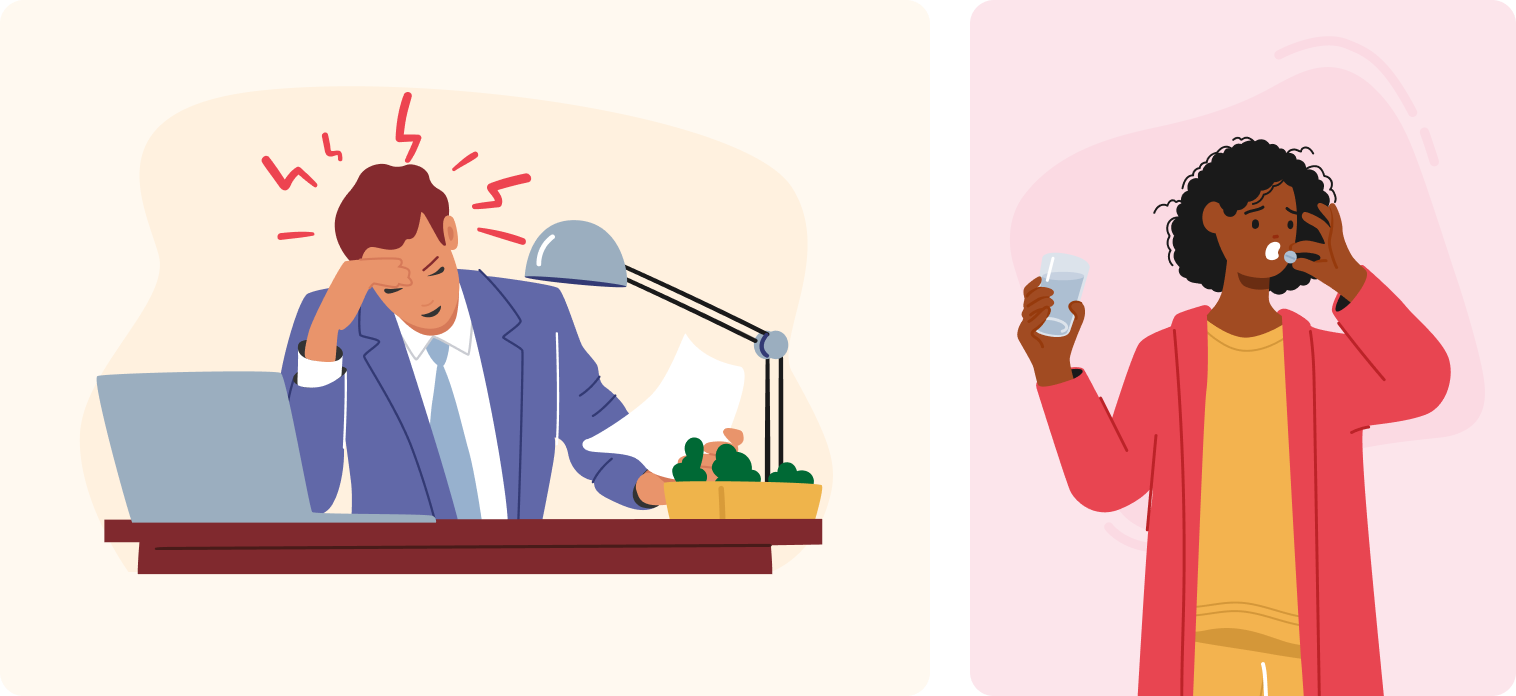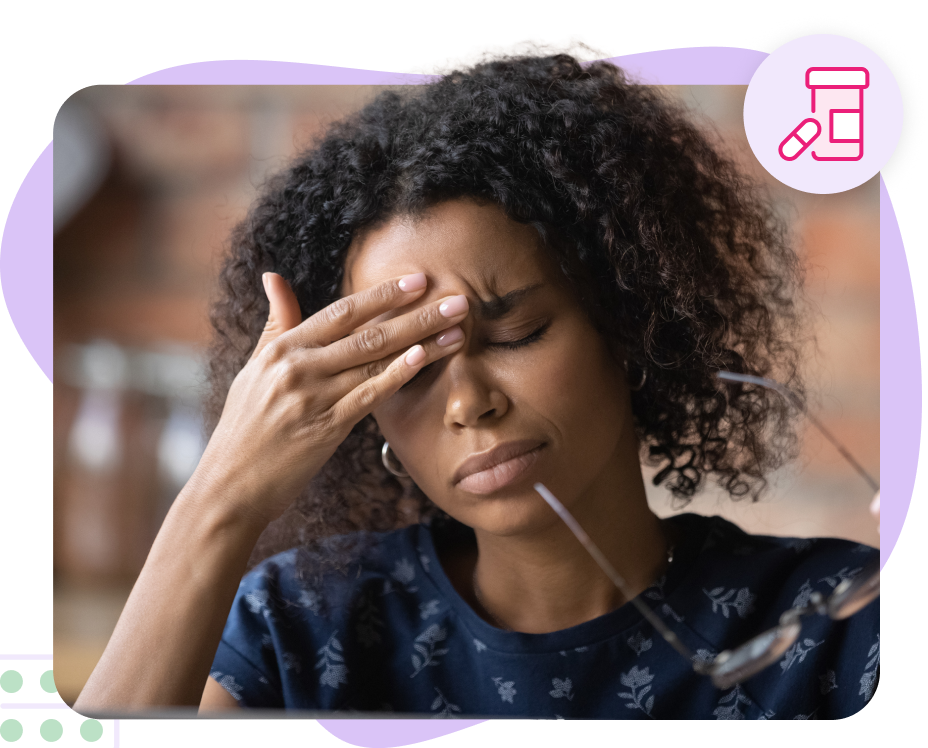Overview
Migraines are a complex, long-term health condition characterized by severe and painful headaches, known as migraine attacks. These attacks are not typical headaches; they are whole-body experiences that disrupt normal functioning and cause many challenges in completing daily activities of living. They are the third most common disease worldwide, with an estimated 190,000 attacks occuring every day in the UK.
Who gets migraines?
Migraines are quite common, affecting around one in seven people, including over 10 million in the UK. Migraines can happen to anyone at any age, often starting at puberty and peaking between the ages of 35 and 45. Initially, migraines are more common in boys than girls, but this changes at puberty, when women become 3x as likely as men to suffer from them.

Types
Migraines are quite complex and can be debilitating for many people. They are more than just a standard headache. There are a number of different ways they present themselves, including with or without auras.
With aura
Migraine with aura, characterized by a warning sign, or ‘aura’, that signals an impending attack, affects about 1 in 3 people with migraines. The aura tends to affect your sight, causing symptoms such as blind spots, flashing lights, colored spots or lines, zigzag patterns, or even temporary blindness. However, auras can also affect your other senses and cause symptoms like numbness, muscle weakness, dizziness, or even confusion.
The aura typically takes about 5 minutes to fully manifest and can last for up to an hour. It’s crucial to remember that the aura generally comes before the headache, although there are times where the headache might not appear at all. There are several types of migraines that come with an aura, such as brainstem aura, hemiplegic, and retinal.
The exact reason behind these auras remains somewhat of a mystery. They might be the result of slow-moving wave of altered brain activity known as ‘cortical spreading depression’. This results in temporary alterations in the brain’s blood circulation, nerve function, and chemical balance.
Without aura
Migraine without aura, which healthcare providers previously called a ‘common migraine’, is the most prevalent type (75% of cases). Unlike migraines with aura, those without aura do not present any warning signs before the onset of an attack. The frequency of these attacks can vary greatly, occurring anywhere from several times a week to only a few times a year.
The symptoms of a migraine without aura typically include a throbbing headache, usually on one side of the head, that worsens with movement. This pain can be so severe that it interferes with daily activities. Other symptoms can include nausea, vomiting, and sensitivity to light, sound, and smells.
Causes
We still don’t know the exact biological cause of migraines. But they appear to be the result of abnormal brain activity affecting nerve signals, chemicals, and blood vessels in the brain. Many people with migraines have a genetic predisposition. Certain triggers, including stress, skipping meals, alcohol, hormonal changes, lack of sleep, and environmental factors (like lighting and temperature), can precipitate a migraine attack in those who are sensitive.
There are several types of migraines, each with its own unique characteristics, but the two most common are with aura and without aura, described below.
Symptoms
Common symptoms of a migraine attack include head pain, visual disturbances such as seeing flashing lights, sensitivity to light, sounds, and smells, fatigue, and nausea. Symptoms differ from one person to another, and migraine attacks can last as little as four hours and up to three days. Some symptoms can begin 24 hours before the actual onset of head pain and last for about 24 hours after the head pain subsides. Most people experience symptom-free periods between migraine attacks, and these symptom-free periods are different for everyone.
Treatment & Management
Treatment for migraines is multifaceted and depends on the type the severity and frequency of attacks, and the individual’s medical history. There are both medication and non-medication options to help you manage your symptoms, depending on their severity.
For acute migraines, ones that start suddenly, painkillers and anti-sickness medications can help stop or shorten the attack. If you experience more than four attacks a month, you can consider preventive treatments, usually taken daily, to help reduce the frequency and severity of the attacks.
You should also review lifestyle factors or triggers that may contribute to the attacks, such as stress, changes in routine, and sleep patterns, with your doctor.
Is there a cure for migraines?
Currently, there is no cure for migraines, but acute treatments can help to alleviate symptoms as attacks occur. These treatments do not prevent an attack from occurring but they can quickly dampen the symptoms. Choosing a medication for acute treatment can be difficult, and it is important to discuss with your pharmacist, and to refer to the patient information leaflet for more information about any medication you plan to use. Let’s discuss some of the more common treatment options.
Medications
These are the main categories of acute migraine medications:
Simple analgesics
Simple analgesics, such as paracetamol and non-steroidal anti-inflammatory drugs (NSAIDs) like ibuprofen, are used to manage the pain associated with a migraine attack. It’s important to note that you should avoid opioid-containing medications due to their potential for short-lived benefits and the risk of addiction. There are some medications available over-the-counter (OTC) at a pharmacy that combine NSAIDs with opioids, such as codeine.
Antiemetics
Antiemetics, or anti-sickness medications, are used to manage the nausea and vomiting that can come with a migraine. Some anti-emetics, like metoclopramide and domperidone, can also enhance the absorption of some analgesics. These should be taken together with any analgesics used for the migraine attack.
Triptans
Triptans are another class of medications designed to treat migraine attacks. These medications work on the serotonin (5-HT) receptors on blood vessels in your brain and they narrow them, relieving some of the pain caused from migraines. They are safe when used appropriately and should be taken at the start of your headache. If the pain returns, a second dose can usually be taken within 24 hours. The oral medications begin to work within 30-60 minutes, but there is a nasal spray and an injection version that works quicker. Side effects can occur, and if they are intolerable or troubling, seek medical advice. If a particular triptan is ineffective or causes significant side effects, other triptans may be more suitable. One of the more common triptans is sumatriptan.
Gepants
There is a newer class of acute migraine medication, known as gepants, which are available if none of the other treatment options work for you. These medications are self-injectable, called calcitonin gene-related peptide (CGRP) receptor antagonists, and may be useful as a preventative treatment when taken regularly. These medications usually require a consultation with a specialist.
Combining different acute migraine medications is possible, especially for those with longer-lasting attacks or recurrent migraines. However, frequent use of certain drugs can lead to chronic daily headaches and medication overuse headaches. If you experience four or more migraine attacks per month, you should consider using some preventative treatment.
Over-the-counter options
For most migraine sufferers, we recommend understanding the following OTC treatments available in our shop:
- Ibuprofen, such as Nurofen, and aspirin can help relieve mild to moderate migraine pain. These NSAID medications work by reducing inflammation and blocking pain signals.
- Paracetamol capsules, tablets, and liquids can also be effective in relieving mild to moderate pain. Unlike NSAIDs, you can take paracetamol with or without food and is the recommended medication for pain relief during pregnancy. Be sure not to exceed the recommended dose to avoid liver damage.
- Combination medications, such as Migraleve and Solpadeine, that combine paracetamol with codeine, buclizine, or caffeine may be more effective than taking these medications individually. Caffeine can also help enhance the pain-relieving effects of aspirin and acetaminophen, but it might also keep you awake, so avoid it in the late afternoon or evening.
- Anti-nausea medications such as prochlorperazine (Buccastem) can help if you have a migraine with aura that is accompanied by nausea and vomiting.
- Topical pain relief sticks or strips, such as 4Head, containing levomenthol, may provide temporary relief from your migraine pain.
FAQs
What is a migraine aura?
A migraine aura is a warning sign that an attack is about to start. It can include visual disturbances, numbness, tingling, dizziness, and difficulty speaking.
Can migraines be prevented?
While not all migraines can be prevented, identifying and avoiding personal triggers, maintaining a healthy lifestyle, and using preventive medications can reduce their frequency and severity.
Are migraines hereditary?
Yes, migraines have a genetic component. If a close family member has them, you are more likely to have them as well.
References
1. National Health Service (NHS). Sumatriptan. Accessed 06/23/23. https://www.nhs.uk/medicines/sumatriptan/
2. National Health Service (NHS). Migraine. Accessed 06/23/23. https://www.nhs.uk/conditions/migraine/
3. National Institute for Health and Care Excellence. Clinical guidelines: headaches in over 12s: diagnosis and management. December 17, 2021. Accessed 6/25/23. www.nice.org.uk/guidance/cg150
4. The Migraine Trust. Living with migraine. Accessed 6/25/23. https://migrainetrust.org/live-with-migraine/



















